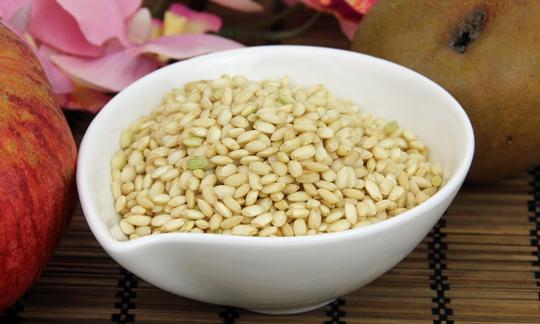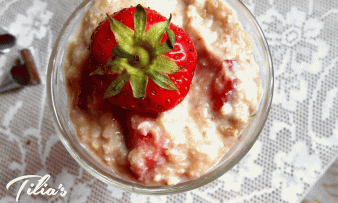Table of contents
Mochi rice is a sweet brown rice ( Oryza sativa) that is mainly used for desserts. Most classifications include it as a medium grain rice variety ( Oryza sativa ssp. javanica), others as a short grain rice variety ( Oryza sativa ssp. japonica), some declare it as a separate variety and call it sticky rice ( Oryza sativa var. glutinosa). 1,2
Using Mochi rice in the kitchen:
What is Mochi rice? or What is sweet rice? Mochi rice or Mochi rice (often incorrectly written "Mochi rice") is a sweet brown rice (whole grain) with a mild, sweet taste. For this reason, Mochi rice is particularly popular in Japan as a typical dessert ingredient. There, sweet brown rice (Japanese: mochigome) is often prepared in the form of small rice cakes for festive occasions (e.g. traditionally for New Year). According to Wikipedia, toughness and excellent stickiness are among the characteristics of Mochi rice.
For the traditional Japanese dish called mochi (rice cake), mochi rice flour (glutinous rice flour) is used. Small balls are formed and filled with a sweet cream or paste made from beans. 3 Mochi rice also tastes particularly good wrapped in nori and served with soy sauce. Sweet Japanese rice is also suitable as a substitute for rice pudding.
The following vegan recipes revolve around the topic of "cooking mochi rice" and provide two popular examples:
Vegan recipe for Mochi (Japanese rice cakes):
Ingredients (for approx. 10 pieces): 200 g sweet glutinous rice flour (Mochiko), 60 g sugar, 150 ml tap water, some potato flour (potato starch or alternatively corn starch).
Preparation: For this mochi rice recipe, mix the glutinous rice flour, sugar and water in a bowl. Heat the smooth dough in a pan over low heat and stir with a wooden spoon until the mixture is thick. Allow the dough to cool briefly.
Then roll the dough on a work surface sprinkled with potato flour and divide it into 10 pieces. Knead the individual pieces into flat cakes, about the size of your palm. Fill the mochi as desired, for example with the classic sweet bean paste called anko, by putting a little paste on the cake and wrapping it up. Finally, shape the mochi into small balls and enjoy the small desserts straight away - or put them in the fridge until serving.
Note: There are some requests for a mochi recipe without glutinous rice flour, but it is precisely the glutinous rice flour that holds the Japanese rice cakes together at the end and gives them their typical consistency. We have not found a reliable substitute product with comparable properties.
Vegan recipe for mochi rice pudding with mango:
Ingredients (for 2 servings): 50 g mochi rice (organic), 170 ml rice milk or oat milk, 150 ml coconut water (or better: tap water), 1 vanilla pod, 1 pinch of salt, 1 tbsp dried goji berries, ¼ mango, 1 tsp hemp seeds.
Preparation: For this vegan mochi rice recipe, scrape the vanilla pulp out of the pod, put it in a small pot with rice milk or oat milk, coconut water, rice and salt and bring to the boil. Simmer uncovered at a low temperature for about 1 hour, stirring frequently. Make sure that the rice does not burn. Add the goji berries about 15 minutes before the end of the cooking time.
Briefly roast the hemp seeds in a non-stick pan without fat and set aside (you could also skip this step). Pour the finished rice pudding into small containers (e.g. screw-top jars), add the sliced mango, close (or cover) and refrigerate. Sprinkle the vegan mochi rice pudding with the hemp seeds before serving.
Vegan recipes with mochi rice can be found under the note: " Recipes that have the most of this ingredient ".
| Not only vegans or vegetarians should read this: Vegans often eat unhealthily. Avoidable nutritional errors. |
Shopping - where to buy Mochi rice?
Conventional supermarkets such as Coop, Migros, Denner, Volg, Spar, Aldi, Lidl, Rewe, Edeka, Hofer etc. usually do not stock Mochi rice. You can buy sweet rice in organic supermarkets ( Denn's Biomarkt, Alnatura), organic shops, health food stores, Asian shops and online shops (such as Galaxus, Amazon). There you will usually find Mochi rice as whole grain rice (whole grain round rice). Mochi rice in organic quality (organic) is available from Davert, for example. In some of the shops listed, especially in the online shops, you can also buy glutinous rice flour, which is used for Mochi (Japanese rice cakes), among other things. You can also find ready-made Mochi rice cakes, including organic ones, in online shops.
Preparing Mochi rice:
The simple soaking method is ideal for preparing sweet Mochi rice and other Mochi rice recipes. To do this, put a cup of sweet brown rice in a saucepan with 2.5 times the amount of water and bring it to the boil briefly at the highest setting. Then turn the heat down to a lower setting and cover the pan. After about 30 minutes, the rice will have absorbed all the water and is ready to eat. It can also be prepared using a rice cooker or a steamer (with a bamboo insert). For the latter method, a pre-soaking time of about 8 hours, preferably overnight, is recommended.
Storage of Mochi rice:
Sweet brown rice (Mochi rice), like all types of rice, is stored in a dark, cool and, above all, dry place. White, peeled rice has a longer shelf life than whole grain rice (approx. 1 year) because it lacks the silver skin and germ, which promote rancidity.
Do not store rice next to strong-smelling foods such as spices, coffee, tea or chocolate, as the rice will absorb their smell.
Ingredients - nutritional values - calories:
Mochi rice has an energy content that is equivalent to that of white long grain rice. The 350 kilocalories per 100 g come mainly from carbohydrates. With 7.4 g/100g protein, mochi rice is rather low in protein compared to other types of grain such as oats (17 g). There is little fat at 1.1 g/100g, but more than in white long grain rice (0.66 g). 4 Classic whole grain rice contains a little more fat (2.7 g) and more fiber (3.4 g/100g - here: 1.8 g).
Consuming 100 g of mochi rice covers 100% of the daily requirement of manganese. The manganese content of 2 mg/100g can be compared to that of raw sunflower seeds, quinoa or chickpeas. Mochi rice surpasses long grain rice (1.1 mg), but not whole grain rice (4 mg). Manganese is important for the formation of cartilage tissue, among other things. 4
There are 200 mg of phosphorus in 100 g of mochi rice. Corn, for example, has a similar amount at 210 mg/100g, while wholegrain rice has 337 mg.Pumpkin seeds contain a particularly high amount of phosphorus at 1233 mg/100g. Phosphorus plays an important role in energy production. However, most people consume too much of it due to the high levels of phosphoric acid in ready-made products and drinks. 4
Mochi rice contains 0.4 mg of vitamin B6 (pyridoxine) per 100 g, which is 29% of the daily requirement. Raw red lentils and kidney beans contain a similar amount, whereas whole grain rice contains 0.74 mg and white long grain rice only 0.16 mg/100g. 100 g of raw pistachios contain 1.7 mg, which is more than the daily requirement of this B vitamin. Pyridoxine plays an important role in protein metabolism. 4
The complete ingredients of Mochi rice, the coverage of the daily requirement and comparison values with other ingredients can be found in our nutrient tables. In the article Nutrients explained you will get a detailed insight into the topic.
Health aspects of mochi rice - effects:
Whole grain rice is generally considered healthy. In addition, brown rice keeps you full for a long time, as the body only digests the high proportion of complex carbohydrates gradually. 5
In general, wholegrain rice should be preferred, as the healthy nutrients in white rice are removed through peeling, polishing and grinding, and the fiber content is also much lower. The outer layers contain important secondary plant substances, such as phytic acid. On the one hand, phytic acid is said to bind minerals from food, which are then no longer available to the body, and on the other hand, it is said to have an antioxidant effect. 6
Rice bran, which is rich in fiber, is often just a waste product from rice processing, but it can be bought and used in a similar way to wheat bran. The antioxidant effect of rice bran supports cancer prevention. 7
After a gastroenteritis or colon inflammation, rice can help to rebuild the intestinal mucosa due to its easy digestibility and slightly astringent effect. 5
Sweet brown rice, like all pure rice, is gluten-free. We recommend that people with gluten intolerance or celiac disease look for a label for gluten-free foods (e.g. a crossed-out ear of corn) when shopping. Otherwise, traces of gluten could be present as the rice is processed using the same machines that are used for grain processing.
White rice has a higher glycemic index (GI) than wholegrain rice. Eating white rice therefore leads to a faster rise in blood sugar levels. If you eat white rice frequently, you are at greater risk of developing type 2 diabetes. On the other hand, wholegrain rice is said to reduce the risk of diabetes if eaten regularly. 8
Dangers - intolerances - side effects:
The use of fertilizers and pesticides in rice cultivation means that the groundwater in some growing regions is heavily contaminated with arsenic and cadmium. The rice plant absorbs these toxins with the water and accumulates them. High levels can also be found in rice cakes or rice flakes. Since small children absorb arsenic even more easily than adults, infants and children should not be fed exclusively with rice-based foods. 9,17
Japanese rice cakes (mochi) often contain a lot of sugar (especially the filling) and should therefore be enjoyed in small quantities. The high sugar content comes from the fact that Japanese farmers used to eat sweet rice cakes to gain more stamina for the hard winter work.
Unfortunately, when eating Japanese rice cakes (mochi), which have a high sticky quality, cases of choking often occur. It is therefore advisable to only bite off small pieces of this delicacy. 10
Folk medicine - natural healing:
A rice soup that has been tried and tested in traditional Chinese medicine (TCM) is said to provide relief for gastrointestinal complaints, kidney problems and allergies. In China, the soup is eaten as a preventative measure and mainly for breakfast. During a fasting cure, it is used (unsalted) for detoxification and drainage. 11
Occurrence - Origin - Ecology:
Mochi rice originally comes from Japan. Nowadays it is grown in the USA as well as in Japan.
Ecological aspects:
Compared to wet rice cultivation, dry rice cultivation is less harmful to the environment and climate due to lower water consumption and lower methane production. 12
The cultivation of Mochi rice seems to be more often conventional than organic. A few suppliers grow the sweet brown rice organically (sold by Davert, for example).
For further information on the cultivation, harvesting and processing of rice, please read the ingredient whole grain rice.
General information about Mochi rice:
Rice is one of the world's most important crops. Rice is the staple food for almost half of the world's population. 13
How many types of rice are there worldwide? It is estimated that there are over 120,000 types of rice. 14 However, the variety of varieties and hybrids makes a clear classification very difficult.
Alternative names:
Mochi rice or mochi rice can also be found under the names sweet brown rice, sweet rice, sweet rice or sweet mochi rice. The spelling "mochi rice" is not correct.
In English, mochi rice is called mochi rice, short-grain rice is called short-grain rice and sticky rice (not glutinous rice) is called glutinous rice. The Japanese name for mochi rice is mochigome.
Key words for use:
Rice is not only used as food. Rice processing produces waste that is not suitable for human consumption, but can be used to make rice oil, wax and protein-rich feed flour. The husks of the rice grain can also be used for building boards and as polishing and fuel. Rice straw is used for livestock farming and as weaving material for mats, sacks and hats. 15
Rice is also used in medicine and in the cosmetics industry. Rice is also important for religious ceremonies or as part of customs (e.g. throwing rice at weddings). 16
Literature - Sources:
Bibliography - 17 Sources
| 1. | Olsen KM, Purugganan MD. Molecular evidence on the origin and evolution of glutinous rice. Genetics. 2002; 162/2: 941–950. |
| 2. | NC State Geneticists Study Origin. Evolution of "Sticky" Rice. Press release. 2002; web.archive.org. |
| 3. | Davidson A. The Oxford Companion to Food. New York: Oxford University Press; 2014: 527. |
| 4. | USDA United States Department of Agriculture. |
| 5. | Roger JDP. Heilkräfte der Nahrung. Advent-Verlag: Zürich. 2006: 212-215. |
| 6. | Graf E, Eaton JW. Suppression of colonic cancer by dietary phytic acid. Nutrition and Cancer. 1993; 19: 11-19. |
| 7. | Borresen EC, Brown D, Harbison G et al. A Randomized Controlled Trial to Increase Navy Bean or Rice Bran Consumption in Coloteral Cancer Survivors. Nutr Cancer. 2016; 68/8: 1269–1280. |
| 8. | Hu EA, Pan A et al. White rice consumption and risk of type 2 diabetes: meta-analysis and systematic review. BMJ. 2012; 344. |
| 9. | Bayerisches Landesamt für Gesundheit und Lebensmittelsicherheit. Untersuchung von anorganischem Arsen in Kindernahrung - Untersuchungsergebnisse 2010 und 2011. 2012. |
| 10. | Nagata S, Kim SH et al. Airway obstruction due to sticky rice cake (mochi): a case series and review of the literature. International Journal of Emergency Medicine. 2018; 11/34: 2-4. |
| 11. | Kanmehr M et al. The Effect of G-ORS Along With Rice Soup in the Treatment of Acute Diarrhea in Children: A Single-Blind Randomized Controlled Trial. Nurs Midwifery Stud. 2016; 5: e25852. |
| 12. | Pini U. Das Bio-Food Handbuch. Ullmann Verlag: Potsdam; 2014: 609-611. |
| 13. | Bücher H. Tropische Nutzpflanzen. Ursprung, Evolution und Domestikation. Springer-Verlag Berlin Heidelberg: New York: 1977: 57-68. |
| 14. | Pflanzenforschung.de Pflanzensteckbrief Reis. |
| 15. | Rehm S, Espig G. Die Kulturpflanzen der Tropen und Subtropen. Ulmer Eugen Verlag: Stuttgart; 1976. |
| 16. | Hochzeitsplaza.de Reis zur Hochzeit werfen. |
| 17. | Bfr.bund.de EU-Höchstgehalte für anorganisches Arsen in Reis und Reisprodukten durch Verzehrsempfehlungen zum Schutz von Säuglingen, Kleinkindern und Kindern ergänzen. Aktualisierte Stellungnahme Nr. 017/2015 des BfR vom 06. Februar 2014. |









Comments